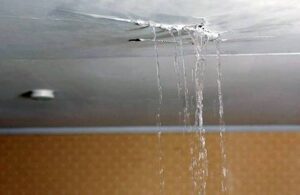Why Roof Storm Damage Matters More Than Ever
Severe weather is trending upward, and roof storm damage is now one of the most common threats to a home’s roof. When a storm hits, high winds, hail, wind‑driven rain, and debris can wreak havoc on a home’s roof, leaving serious roof damage and costly repair costs in their wake. Most homeowners assume their roof can handle bad weather, but the truth is many roofs are vulnerable under today’s extreme conditions.
In 2025, heavy rain and strong wind events are more frequent, increasing the chance that your roof will suffer visible damage. As part of the roofing industry’s ongoing research, roofing contractors have noted that insurance claims from storm damage have spiked, especially claims for missing shingles, loose shingles, and leaks. That means more and more homeowners are facing the realities of roof replacement or major repairs.
Common Types of Roof Damage After a Storm
Wind Damage & Loose Shingles
High winds exert uplift forces on shingles. Loose shingles may curl, lift, or detach entirely, exposing the roof deck beneath. That loss of protection can open the path for water leaks and further damage during subsequent storms. Wind damage is a major concern, especially along edges and roof ridges.
Hail Damage
Hail damage is one of the more insidious forms of roof storm damage. Asphalt shingles may incur dents, cracks, or granule loss. Over time, that damage weakens the shingle’s protective surface. When hail strikes blow holes in shingles, hidden damage may exist even if visible damage is minimal.
Water Intrusion & Leaks
Once the outer roofing materials are compromised, heavy rain can drive water into the underlayment or roof deck. Water leaks may begin small but lead to rot, mold, and structural damage if unchecked. Standing water on flat or low‑pitch sections accelerates deterioration.
Debris Impact & Broken Glass
Debris such as branches, roofing fragments, or broken glass launched by a storm can puncture roofing materials or crack tiles. Even impacts that seem minor can cause microfractures that worsen over time.
Gutter Failures & Overflow
Gutters clogged with leaves and debris may not handle wind‑driven rain, leading to overflow or even detachment. When gutters fail, water can pool near roof edges or saturate fascia and soffit, creating water damage and mold risks in eaves and attic areas.
How to Spot Storm Damage Early

Visible Signs from the Ground
Look for missing shingles, curled or cracked shingles, dented flashing, or granule accumulation in gutters. You might spot broken glass, cracked vents, or even debris perched on your roof. These visible signs often indicate deeper issues.
Inspecting the Attic & Interior
Inside, check for water stains, damp spots, mold, or sagging areas in the attic or ceiling. If you see dark patches or blistering paint just below the roof, that may point to water intrusion.
When to Call a Professional for a Roof Inspection
If any of those signs appear, or if a storm has just passed, schedule a full roof inspection. A skilled roofing contractor will climb the roof safely, inspect flashing and underlayment, check the roof deck, and document all damage.
What to Do Immediately After a Storm
Act Quickly to Minimize Further Damage
Time is critical after a storm. Act quickly: cover exposed areas with tarps, clear gutters of debris, and make sure downspouts direct water away from the foundation. Doing so can prevent further damage until you arrange permanent repairs.
Safety First
Avoid walking on a damaged roof yourself. Branches and weak spots may hide structural harm. Instead, observe from the ground or hire a pro.
Document Everything for the Insurance Claim Process
Take photos and video from multiple angles, record visible damage and broken items, and preserve any roof fragments. File an insurance claim promptly with your insurer, providing all documentation.
Why You Should Call a Roofing Contractor

Even if damage seems minor, hidden issues often lurk beneath the surface. A professional roofer can uncover problems in flashing, underlayment, decking, and ventilation. In addition, hiring the right contractor helps when dealing with an insurance company, they can assist you during the inspection, helping ensure your claim reflects all necessary repairs or replacement.
A reputable roofing contractor in Northern California will know local codes, climate demands, and storm patterns. They’ll provide a transparent estimate, help you navigate the insurance policy details, and stand by the work long term.
The Insurance Claim Process for Storm Damage
Filing a Claim
Once the storm is over, contact your homeowner’s insurance company and report the damage. Provide photos, inspection reports, and a breakdown of needed repair costs or replacement.
The Adjuster Visit & Claim Evaluation
An adjuster from your insurance company will visit to evaluate the damage. The adjuster determines what is covered under your insurance policy and how much the insurer will pay. Because many homeowners don’t know what to expect, having a roofer present can help identify hidden damage the adjuster might miss.
Common Pitfalls with Storm Claims
Some claims are undervalued because the insurer or adjuster overlooks damage in the roof deck, underlayment, or secondary supports. Others deny the claim if damage is deemed preexisting or due to wear and tear. That’s why documentation, timely action, and contractor involvement are so important.
Roof Replacement vs. Repair
When a storm causes widespread roof damage, sometimes the only long‑term solution is a full roof replacement. Minor damage may only require targeted repairs, but you need to weigh the cost of segmented fixes over time. Roof replacement ensures the entire structure is renewed, offering better protection against future storms and often lowering future repair costs.
How to Prevent Roof Storm Damage

Routine Roof Maintenance
Consistent roof maintenance is key to reducing vulnerability. Clean gutters regularly, replace damaged shingles on sight, and check flashing for signs of wear. Maintain proper attic ventilation and insulation to reduce thermal stress.
Upgrade to Storm‑Resilient Materials
If your roof is aging or repeatedly damaged, consider upgrading to impact‑resistant shingles or reinforced underlayment. Stronger materials resist hail damage, reduce granule loss, and stand up better to wind and storm stress.
Tree Trimming & Landscaping Awareness
Keep branches trimmed so they’re not overhanging your roof. Falling limbs are a common cause of damage during strong storms. Also consider removing dead trees near the home.
Address Problems After Each Storm
After every major weather event, inspect the roof for signs of damage. Prompt repair reduces the chance of water leaks or further damage in subsequent storms.
Why Working With Cobex Makes the Difference

Cobex Construction Group understands how storms test a home’s roof. We pride ourselves on being the right contractor to help you through every stage: inspection, repair or replacement, claims support, and long-term protection. Our team is licensed, insured, local, and experienced in California’s harsh weather conditions.
We walk you through the insurance claim process, provide transparent estimates and help you protect your home. Choosing Cobex means you get a trusted local roofer, not a fleeting storm chaser.
FAQs About Roof Storm Damage
How can I tell if my roof has storm damage?
Look for visible damage such as missing shingles, loose shingles, granule debris in gutters, dents or cracks, interior water stains, or mold growing near ceilings.
Does homeowners insurance cover storm damage to a roof?
Most homeowner’s insurance policies cover roof damage caused by sudden, external events like hail or wind. The insurance company will evaluate whether the damage is covered under your policy coverage, so prompt filing and documentation matter greatly.
How much do roof storm repair costs typically run?
Repair costs for minor damage often range from a few hundred to a few thousand dollars depending on roof size and materials. Major repair or full roof replacement costs vary widely depending on the extent of damage, materials, and location.
Should I repair or replace my roof after storm damage?
It depends on the severity of damage, the age of the roof, and the cost difference. If damage is extensive or recurring, replacement may be more cost‑effective than patching repeatedly.
How soon after a storm should I arrange a roof inspection?
As soon as conditions are safe, ideally within days of the storm. The sooner you inspect and document, the better your chances to prevent further damage and support your insurance claim.
Conclusion & Next Steps
Roof storm damage is a serious threat when severe storms, high winds, hail damage, wind‑driven rain, debris, and broken glass combine to test your roof’s defenses. When a storm hits your area, you need to act quickly: document visible damage, cover exposed areas, and schedule a professional roof inspection. Proper maintenance, strategic upgrades, and partnering with an experienced roofing contractor make the difference between minor repairs and major replacement costs.
If your home has experienced storm damage, or if you want to protect your roof against future storms, contact Cobex Construction Group today. We’ll assess your damaged roof, guide you through the insurance claim process, and deliver a solution built to last.





























